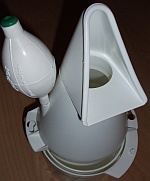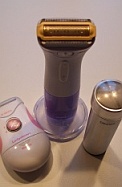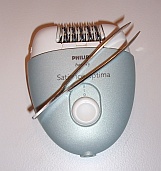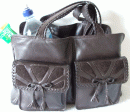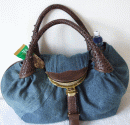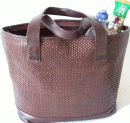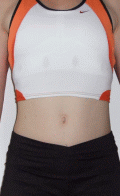Going to the bathroom is easy. You go there, open the door, enter, close the door and there you are!
After that: Only you know. Oh these euphemisms! It’s supposed to be a silent business and preferably an untraceable one these days. I’m always happy if there is some music in public toilets or if somebody is running the hand dryer at the right time. If you visit old castles they sometimes show a different picture of toilet culture. I saw something like this at
Norwich Castle when exploring the 'Castle Keep'. While sitting there together and getting comfier as released from some burden, our elders may have discussed politics that might have changed the world. Probably it’s not a good idea to go back to the very old days, then.
However we are fascinated and disgusted at the same time watching people on the telly getting their colon washed or having their bucket full of poo analysed while not being able to talk about problems we might have ourselves. And I’m rather sure that at one time or another everybody has some trouble with the toilet business.
So, let’s talk business!
You might have noticed already that I’m a bit obsessed with how our ancestors lived. I believe that their lifestyle holds a lot of answers to our questions arising from modern life. And one of the questions I always was wondering about was: How on earth did they cope without toilet paper? Apparently it was invented in
1391 in China, but what did people do before that? And thinking back much further when human kind probably was a bit hairier than now, and didn’t have underwear to change daily, and washing machines, and water taps,…
Now eventually I found out: They had better digestion, they didn’t need toilet paper!
Toilet Paper vs. Diet
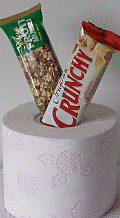
Since I changed my diet my toilet paper consumption has been drastically reduced. It’s the so much-vaunted high fibre food. Imagine our ancestors roaming the countryside minding their business and then getting hungry. Sh… no supermarket around to get a snack. They had to pick some berries here and some leaves and seeds there. Linseed for example grows vigorously throughout the year - at least it does in my garden - and it is very tasty and nutty in flavour. And it has another speciality. It develops some gelatine like surface when getting wet. And that stuff makes stool slippery and good to handle for the colon. As does any other fibre – given that there is enough water around.
I heard a story once that an elderly woman was submitted to hospital with cramps and they had trouble big time to clear her guts out. Older people seem to have trouble taking in enough fluids, so she had some indigestion problems from dehydration. When she heard that whole grain products would help she ate that stuff dry without drinking more than usual adding to her problem instead of taking it away. Her whole guts were full of rock hard pellets.
So getting the balance right in adding whole meal, dry fruit and seed components to the diet and having a drink with it is essential for healthy stool (well formed and slippery – imagine a chocolate bar when it got just a bit too warm) and hence healthy guts. Still fancy a chocolate bar now?
Slogging Your Guts Out
Another thing that can cause serious trouble is our rather hectic and inflexible lifestyle. O
ur ancestors didn’t have the time constraints we have to face these days. ‘Need to leave the house now, but not ready for toilet yet, probably in 20 minutes – bad timing – keep it in, can’t go within the next hour.’ The longer it’s kept the harder the poo gets, and at the end of the day one might have missed it altogether already feeling very much indigested.
Then comes family dinner, the only real family time of the day so that is not to be skipped and anyway: 'You deserve a decent meal at the end of the day!', followed by a not really good night sleep. Next morning eventually pressure reaches top level but for some reason it won’t come out. Pressing hard the eyeballs feel like popping out and eventually – relieve. Happily leaving the house being in the middle of school run one might start feeling a rumour and then things go quickly, everything from sweating to panic attacks – a loo is needed, one has the runs!
Having had this experience of panic attack and embarrassment makes things worse the next time round and panic rises even more quickly, sometimes even before leaving the house, but no guts rumbling, no reason for panic, or is there? Impossible to grasp that one can have indigestion and the runs at the same time the doctors might be consulted. And the diagnosis often is ‘food intolerance’ or ‘irritable bowl syndrome’, and there might be some ‘haemorrhoids’ as well.
Good news is that you don’t entirely rely on the doctors for help. With amending your diet towards the mentioned above you might be partly successful already. That doesn’t mean that you have to change everything completely and at once. Only adjust little things which you actually might like. I got lucky, because I found my favourite bread recipe – working on it to get it online for you – and having a browse through the bread shelves or dropping in at a local bakery or farm shop to find good whole grain or even sourdough bread doesn’t hurt.
I found a liking for muesli bars, although they are tricky. They make a good snack but in a 'snack situation' it is easily forgotten to drink enough. That’s when they are starting to backfire – in a very literal sense of the word. I never go anywhere without a bottle of water. People are wondering why I always wear big handbags, …if they knew!
 Toilet Culture
Toilet Culture
That we all go to the loo more or less regularly for all our lives doesn’t mean that we know how to do it. When I was still a school girl we had 'Design' in our arts class and some of the 'naughty boys' wanted to show of their guts and chose: 'Design of the perfect toilet'. Everybody was giggling away and the teachers didn’t seem to expect a lot of it either. But actually they did some extraordinary work.
They went to meet a nurse who at the beginning was a bit overwhelmed by their request and then told them that leaning back a bit actually would give the guts the least obstruction so that gravity could do it’s work best. So they actually built a loo with a comfy back and leg rest and of course some attachments for drinks, papers, telly and whatever else comfort man needs on the throne. BTW: they got an 'A'!
Years later after suffering from what I called a 'weird belly' for quite a while – what did I know at that time about 'irritable bowl syndrome'? – I recalled their work and started to experiment with different postures on the loo. I never went to the doctors, firstly I was too embarrassed by the nature of the matter, and secondly I thought myself to be a bit bonkers: How could the doctors help there?
Over the years I refined the technique and then eventually even got confirmation for my discoveries from my mum – the only person who talks freely about such things. We were on holiday together and new environment, new food and new rhythm needed some adjustments on the toilet routine. So we started talking and giggling and she said that they had been talking about this in her Yoga class. Damn! So many years of experimenting and the knowledge was all there – only that nobody talks about it! That’s about to change. Here is my guide on:
How To Go To The Toilet
Never, ever press!
 |
| Firstly you look silly, and secondly: It will give you haemorrhoids. The usual way of pressing with taking air into the lungs, holding breath and then tightening the tummy muscles while bending slightly over is highly counter productive. The intestines get pressed together what doesn’t help the flow and the pressure in the blood vessels is increased. I had a friend who had vessels in her eyes burst from pressing too hard, she looked like a zombie. |
Located around the sphincter which is the strong muscle which keeps everything in at your will, are a lot of big blood vessels. If you press too hard you make them swell and actually obstruct the exit. Or they may slip out and show as haemorrhoids. The theory of haemorrhoids is a bit more complex, but I guess you get the picture.
Don’t read!
I know: If it needs a lot of time then it’s so booooooring! And it might be the only private place where you actually have time to read. However, how can you feel what’s going on inside you when you are thinking about something else? Make the toilet session a one-to-one with yourself. After a while you will know when it is worthwhile waiting a bit longer, or when to give up and to try later. Additionally the posture isn’t good because usually when reading one would sit bent forward, what is not entirely wrong, but if it doesn’t go along with the correct way of breathing it can be rather obstructing. And thirdly: You need your hands and arms for something else anyway. You won’t be able to hold the book.
Don’t sit too long!
If you already have needles and pins in your feet something is not right, you should try later again. Have a big glass of water every half an hour or so.
Getting to know the enemy
The troublemaker is the large intestines (colon). The colon has to do the fibre digestion (although some fibres go through without ever being digested) and water retrieval. There are up to 8l of water extracted from the digested material per day. So it is basically a water recycling station of the body. It is almost 2 m (if I converted that right that is about 6.5 feet) long and I guess that's why it coils around all the other organs and bends 4 times, to somehow get it into the tummy without crouching it too much. Although I feel that it clustered enough already. But have a look where it actually wiggles along:
| Somewhere from the bottom right hand side (A) the colon comes up as a rather big thing rising almost up to the rib cage. It bends (1) and goes above the belly button across to the left side sagging a bit in the middle (B) and then bending again (2) and going down and towards the back (C). During all this it’s getting thinner and when it reaches the pelvis ground (3) it rises up again, now getting bigger, wiggling a bit left and right, back and forth and eventually bends down (4) to end in the anus (D). |
|  |
The picture from
Gray’s Anatomy shows the small intestines in the middle of the large ones. Although parts of the whole stuff is fixed to the back it is a confusing matter and there is no wonders that if we don't keep the contents smooth and slippery the one or the other bit gets stuck.
Ideally the duration of passage through the whole of the body from eating it to going to the loo is 24 hours. In a BBC TV series called '
Truth about food' they changed the diet of two truckers from junk to fibre and the result after only 10 days is amazing. And it shows - It's possible to pass what you are eating within 20 hours.
So basically the time the food is in the colon should be rather short. But these bends are not really helping. On top of that the colon has two types of movement. In the middle bit (B) it's shoving its contents to the left AND the right to mix everything through. Great! Feeling stuffed already and then it's trying to mix it.
Then comes the most stupid bend (2). If you are really indigested and something is stuck in the middle bit (B) you can even feel the shape. To get it moving through this sagging bit, massaging it up and over the bend so that it then can move downward on the left side guided by gravity is the task ahead.
Breathing …
Breathing! We do it so naturally, don’t we? We don’t think about what is happening and what impact the filled lungs can have on the rest of the body. To get a bit of an understanding what we are actually up to we need to know a bit how the body is build.
The big bit of the body where head, arms and legs are fixed to (basically what you see in the picture above) consists of two parts, although it pretty much looks like one. The top bit is the rib cage containing the lungs and the heart. It is sort of sealed from the other part by a thin layer of muscle going across like a disk called diaphragm. The lower bit that is the belly has the pelvis as sort of a bowl where the intestines lie in.
You can imagine it as one bowl upside down which is the ribs, another bowl which is the pelvis and the diaphragm in the middle keeping the contents of each bowl apart. It’s a bit like a trampoline, rather flexible and it can arch in either direction - up or down.
There are two ways of breathing:
…into the chest!
In this case you breathe in and make your lungs wide. It’s the usual way of breathing. It spreads the rib cage and you feel that the bra sits a bit tighter. This pulls the diaphragm up and induces a bit of suction on the belly.
…into the belly!
In this case you make the lungs long when breathing in by pushing the belly muscles out. That makes the diaphragm arch down and puts some pressure on the organs below. The shoulders are not moving at all and the belly gets bigger and thinner as you are breathing in and out. It's best practised while lying on the back. As the rib cage is held to the ground it doesn't widen that easily and then belly breathing comes naturally. You can see the tummy slightly moving up and down.
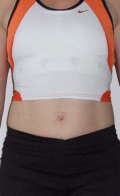 |
| |
| 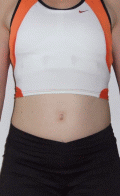 |
Normal |
| Chest |
| Belly |
On the '
Normal' picture you can see a bit of chubby bits above the pants and a round belly button, indicating that the diaphragm is a flat disc going across the thorax at about the height where the bra ends.
In the '
Chest' picture the middle bit is stretched up, the chubby bit is gone and the belly button is long, indicating that the diaphragm is working like a suction cup on the contents of the belly. The suction is induced by the lungs sucking in air due to spreading of the rib cage.
The '
Belly' picture is a bit hard to see as the stretch goes to the front. But you can see that there is nothing hanging above the pants, the belly button is not as round and the surface looks smoother. The diaphragm now is a suction cup towards the lungs pulling them down. This is achieved by pushing the tummy muscles out.
Imagine what your guts are doing when sitting crouched all day. I always feel it a relief to stand up straight and take some deep breath into the chest. I then can feel the rib cage widen and the belly to be sucked in. Everything in the belly get’s sucked up a bit and then sinks slowly back while breathing out. It’s like giving the intestines the chance to re-arrange themselves and to have contents that got stuck in the bends move forward.
Sitting on the loo the belly breathing is the one that will help to massage the guts and to enforce peristaltic movement (that’s the sort of wiggling movement the guts are doing naturally to move their contents forward).
 Applying pressure from the outside!
Applying pressure from the outside!
Whenever we flex a muscle deliberately we unknowingly tend to flex a few neighbouring muscles as well. So instead of using the tummy muscles to apply pressure and meanwhile tensing up everything else with it, use your arms and hands to apply pressure from the outside while leaving the rest of the body relaxed.
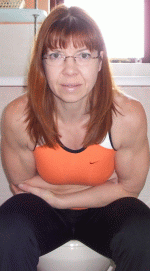 |
| When sitting down cross your arms in front of the body at about the height where the ribs end. That is just above that bit of colon that goes across (B). Bend forward that your arms are squeezed between belly and legs. I have short legs for me it actually works best in high heals otherwise I'm on my toes. That way you already should feel some pressure inside that is directed downwards. |
 |
| Now breath in deep and slow into the belly. Blowing up your belly by pushing the muscles out, you should feel yourself lifting up a bit more as if you were lying on a bellows pump.
This way you are keeping the pressure at the same level. When breathing in it comes from the lungs from the top and when breathing out it comes from your arms from the front.
Because the arms are tucked in between tummy and legs you can apply the pressure very evenly by just leaning against them using the weight of your upper body. If you would sit upright just pressing your arms or hands against the belly you would tense the neck and the back as well. It would be very tiring and the pressure wouldn't be as continuous. |
The Yoga version of my mum doesn't cross the arms but presses the rolled in fists into the belly. I never got the grips on that one, but she can't do my version. So you may want to experiment a bit on the best posture. But whatever posture you choose - you have to admit: No way to hold a book!
Lean back and relax
If you got used to the above you should feel the belly nerves rumouring after a short while and it's time to bring into practice what the boys found out with their 'loo project'. Give freedom to your guts.
Lean back, pulling the cheeks a bit apart. BTW: you know that you gained or lost weight when your bowl all of a sudden doesn't fit your bum as well as it used to. Very weird feeling that!
However, make yourself comfy, probably use a towel around your neck and wait. |
| 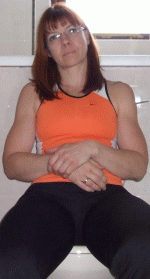 |
I'm rather religious about what I call my meditation time. With this soft pressure massage I can bring forward a due business to up to 30 minutes. I tried this out using my way to work. I don't have it far, so I usually can risk to leave the house and I know exactly the feeling and the timing now and when I have to rush to the toilet there. But if we are planning for trips I take my time even if I don't feel the urge and I usually get the task done, so that we can leave in time. For me the understanding of how this bit of the body works and to find out how to get the pressure to the right area has improved my quality of life immensely. So I hope that all the theory I've put you through will give you the one or the other idea.
To an always brilliant business!

